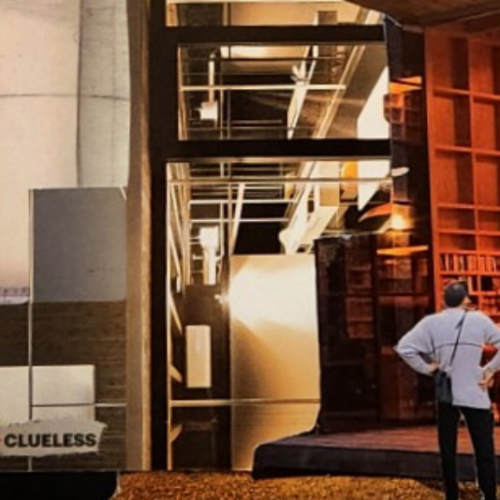1.
The first time I played Bach on the piano, age eight or nine, I was startled to find how much it soothed me. Soon, I couldn’t bear the stress of my house without the immediate feedback of the piano keys, the press of fingers, the requirement to attend to each black mark on every page, as if I were learning a new map, or the rules of the world.
Practicing Bach continued until age fifteen, when cross-country and pre-college classes eclipsed the need to play. But in those years, I played because it brought bliss, or as close to bliss as I could come at the time. Pressing one pedal, then the next, I dove into the music’s memory: the Goldberg Variations, the Well-Tempered Clavier.
Music offered me a space green as a bower of plants, filled with muscadine and the scent of rosemary. Within it, time and space collapsed, or rather, I could collapse into them.
Because my hands were moving, because my body was still, I was able, in a bounded way, to feel.
2.
Outside, robins chirped, but I couldn’t hear them. Puddles dried up, like the ones I’d splashed in long ago, filled with the muck and rain of Georgia summers, where humidity frizzed hair and cicadas beat their wings, desirous, where lightning storms sent us running for the basement.
A woodpecker nested outside my bedroom window, waking me each morning with pounding, sure and sturdy. The lawnmowers the neighborhood residents liked to ride gave the impression of motors grinding over sand. There were the house’s shouts and silences; the echoes of children playing in the cul-de-sac.
I didn’t listen; I didn’t need to. As the Bach rose from my fingers, I listened only to each of its individual sounds. Against the scent of rosemary and muscadine grapes from the open window, I dug into its geography. That music was writing a story, and I’d let it be written. I’d play each variation til the end, loving the challenge: the strain of fingers, the blur of vision from parsing the notes, the cessation of all thoughts except musical ones. Whether I was hungry or not didn’t matter. The music, as it unfurled, was food. Its intricate patterns brought my mind into alignment and told my body that it was fine.
There were wild parts of me, uncontrolled parts, I knew, even back then, but the music didn’t mind. There was trouble in the family, trouble in school, but the Variations made those troubles optical illusions. Those pieces held such tenderness, such grace and compassion. They seemed to know me from the inside out: how the summer heat burned my soles, how the season fell upon me, too rich in its landscapes of magnolias and budding white blooms. The Variations contained everything: The strip malls at the edge of the suburb. The reservoir someone was rumored to have drowned in. The unexpected storms that broke the incessant heat. The galloping horse I’d ridden, on a few precious lessons, through muddy fields.
In those Variations, I saw the light of early mornings, the dusk of evenings, blues and pinks, and the brush of Spanish mosses as I raced through the woods in summertime. I saw the green glow of the night vision goggles I’d borrowed to run through the yard late at night. The tomato plants glowed. The petunias and flowerpots turned luminous, monstrous even. How long might I stay in this house? I wondered. What would happen if I left? What if I never did?
In those Variations—which I played on the old upright facing the window in the living room, a room decorated with colors of the sea—every sensory detail fell into place. There were my feet, only recently able to reach the pedals. There was the tamping down and heightening of sound. There was the blaze of dervish energy, which the music calmed and soothed, saying I was human, I was helpful, no longer fierce, not inflamed. The music held a grammar of intention, reminding me I was a child with a child’s energy. I was eating pears on toast with cinnamon sprinkled on top. I was washing the ceramic plate and setting it on a clean towel to dry.
The architectural beauty of that music, its well-paced energy, transferred into my heart, which beat more calmly. Its syntax unclenched the fist that had grown in my chest’s center, the fist that hurled and hated and told me I was terror itself.
In the silence between each Variation, the metronome clacked. The grandfather clock bid hello, goodbye, hello. In another room, a toaster clicked off. Then: silence. Silence as delicate as the nectar drop at the end of a honeysuckle stem. A flash of that honeysuckle: removing the stem and sucking it, then stamping the petals. Grinding them all summer long.
3.
Now, when I play, it’s with the knowledge that there’s no such silence. I’ll be interrupted at regular intervals by Paul, by his voice and his curious five-year-old hands. Most of the time, I welcome the interruptions, especially when he wants to join in. As if we’re playing duets, I take the treble and he the bass, which he bangs so loudly I can’t detect the sharps and flats, or even catch the arc of a phrase. In the thunderous noise, my son’s face lights up.
“I’ve got it!” he calls. “A new song. I’ve invented it!”
He’s thrilled to see how his interruptions can disrupt our rhythms. Leaning in, he pounds with both fists. Later, soothed, he shifts to the higher keys and taps out a few careful notes. His music reminds me of him: sometimes tempestuous, sometimes tender.
“Just one more thing,” he says at night, and before I can tell him it’s too late for more stories, he takes my hand and plants a kiss on my palm.
“That’s all,” he says, so simply, before scampering off.
4.
There are thirty variations in the Goldberg sequence. Each one seems to instill another, slightly different mood in Paul: blustery, melancholy, loud or louder.
Sometimes, in the evenings, he asks what it’s like to be a “piano-ist.”
Occasionally, he begs for lessons.
“Some kids are learning piano in school,” he tells me. “Or drums.”
“Are they?” I manage not to say, Anything but drums.
“Let me be your teacher,” he says with an impish smile.
“How should I do that?”
“Easy. Just pretend you don’t know how to play.”
In the late evening light, under the glow of screens from neighboring apartments, he draws himself to his full height, then pats the piano bench.
“Sit down,” he says.
Taller than most kids his age, he still looks tiny, his features delicate. I can recall the same hillock of his nose on the ultrasound.
“Okay…” I sit and do my best to pretend.
“Like this,” he says. He sets his hands out straight on both sides of middle C, then licks his finger and calmly turns the page of the Variations, as he’s seen me do. Perhaps he knows me better than I know myself, or at least, knows the calmed or calmer parts of me.
“You have to hit this note once, and this note twice,” he says, mimicking me. “Go up and then down, if you want to play Twinkle Twinkle Little Star.”
In my first rendition, I make a few errors on purpose. Then, at his encouragement (“You have to mess up,” he whispers), I make more.
“That is not good.” He makes a show of being diplomatic. “You need a teacher.”
“I guess I do,” I say, sharing his smile.
In mock disappointment, he searches my face and hands, then returns to the keys.
“Everyone knows this song,” he says, reprimanding. “You should be able to play it. It isn’t too hard. Here, try a little harder next time.”
In his gentle chiding, I hear how he must talk to himself. Try harder. It isn’t too hard. The frustration must feel constant: the sense of being unable to do what seems so simple to adults. For him, music must feel not only a pleasure, but also a challenge: a call to remember a complex series of patterns, to keep in mind more than he thinks he can.
But he doesn’t comment on this struggle, or on the mistakes I make afterward, as I turn Twinkle Twinkle into something jazzy and strange. He only removes the Post-it notes I’ve placed on the keys, showing the order of notes, and dumps them unceremoniously on the floor.
Those notes, filled with numbers I’ve scribbled in black pen, were meant to help him keep track of the sequences of notes. They’re wrinkled, their stickiness lost from overuse. In any case, as I came to find, those notes confused him, leading to more errors than not.
“Try again,” he says, with an encouraging smile, amid the scatter of Post-its. He puts an arm around me, as I’ve done with him a thousand times. “You’ll get there.”
And I tell him I’ll try harder, I will.
On Percussion
- “I want to make loud, banging, crashing noises,” Paul says, age four.
From six in the morning until eight in the evening, he runs.
He stops once in a while, like at dinner, to gobble pasta or chicken with tomato sauce.
He races down hallways, sometimes carrying a toy robot that repeats everything he says in a maddeningly mechanical tone, sometimes clutching a wadded-up piece of paper, which he throws at the wall, sometimes cradling a football, sometimes with nothing in his hands.
For a few seconds, watching my face, he runs with small, delicate steps.
Then he ramps up and zooms around like a furious bull whose tail is on fire.
Around the apartment he races, as if he has an internal motor that won’t cease.
“Can you hear me? Can you hear me?” he asks.
“Can you hear me?” the robot repeats.
“Oh, I can hear you,” I say.
- These are questions I scribble down at night but forget by morning:
If our fates are to be circling this galaxy, how will we ever find the center?
If we’re a naturally quiet species, what does it mean to be surrounded by sound?
Could death be simply a transition into a world of absolute music?
Could the music we have now be only a hint of what’s to come?
Is that why music thrills us, reminding us of where we’ve been, or where we’re headed?
Does music link to pre-life, or after-life, or both?
Perhaps the Egyptian scarab, and all other mummified creatures, were simply chords?
Every night, I record these questions, only to let morning erase them.
For better or worse, they never linger.
Perhaps in the morning, I find such existential questions laughable.
Or perhaps in the morning, there’s simply too much else to hear.
- But then come days when the robot noise is the least of my worries.
For months, I’ve feared the breaths others have breathed in the elevator before me.
I’ve feared the breaths of people who swim too close in the pool.
On the Open Water Swimming discussion board, of which I am a new member, having recently taken to lake swimming, there’s heated discussion. Is the snorkel allowede in swimming pools? Are snorkel-breaths dangerous, due to the forced nature of the exhalation?
“Paddles are all right, and goggles, but no one should be allowed to bring snorkels.”
So went the decision, in the end. Most swimmers concurred. Others pointed out that this was an open water discussion board, and swimming pools had nothing to do with open water. Such discussions, they argued, should only be allowed on slow news days. - What I mean is, I love the noise so deeply and yet long, simultaneously, for it to cease.
- Nightly, I write a story for my daughter Sophie, age nine. In this story, which we read and revise before bed, the main character is named Nancy P. Potato. Nancy says this is her name because her family loved potatoes. They lived in Idaho, a land famous for potatoes, and tilled the soil until there was no more soil to till. The P. in Nancy P., she says, also stands for Potato. But she’s fine with just Nancy, or Nancy P. My daughter laughs. I don’t tell her that Nancy was my middle name until I got married, changed my last name, and deleted the middle one. Nancy was the middle name of my paternal grandmother. While I think of that lineage, it doesn’t fit the mood, so I don’t bring it up.
All day, Nancy P. sings songs and has the worst ideas.She makes vats of soup out of potatoes and orange peels, the way her grandma did.
She tells stories of her grandpa, who built horses from metal and pretended they were real, until he fell off a horse and was never quite the same. To fix him, her grandma made vats of soup out of bread and cheese and cut-up carrots, anything she could find on the farm.
Most nights, Sophie delights in this ongoing story.
At dinner, she tells me what Nancy P. should and shouldn’t do.
She has her own strong opinions; she knows Nancy P. better than I do, she says.
Her face lights up as she tells me Nancy P. would like this and wouldn’t like that.
As she speaks, I can feel Nancy P. hovering over us, planting thoughts in our heads.
I don’t know where this Nancy has come from, a shade of my grandmother, perhaps.
Now that I’ve invented her, or conjured her, she doesn’t seem to want to let us be. - And so there’s that lifting, that lightness, but then noise descends.
Noise always strikes me as worse in winter, worse when the snow coats the cobblestones and concrete and makes shouting echo even more.
“Misophonia, or hatred of certain sounds. It’s a common disorder,” a friend tells me, when I explain my noise avoidance. “It doesn’t necessarily mean you’re anxious.”
I laugh half-heartedly.
For her, it’s the sound of a car backing up a driveway that sets her off. For me, it’s not only the running. It’s also the stabbing of food when people act as if their steak or chicken will get up and run off. As if an aggressive hand is needed to keep dinner under control. That, and the vacuum cleaner, and tantrums lasting longer than fifteen minutes.
For a while, I tolerate it, even laughing at how petty my irritation feels. Imagine the sound as a pleasant thing, I remind myself. But then, as the sound builds, I sense my limits.
I have white-noise headphones I put on regularly.
I can have whole conversations, I’ve come to learn, while wearing them.
If necessary, I can remove the headset from one ear so I can half-hear. With that solution, the noise comes to feel tolerable, the piano less like an attacking monster and more like a creature I can approach, even enjoy. Even the odd gazes don’t much bother me—although I’m well aware that I look weird.
“What’s wrong?” Sophie asked me once, when I was attempting to ignore the sound of a balloon being bopped around the room. “Are you mad, or concentrating?”
Concentrating, I said, and held my tongue.
It wasn’t only the quiet of the headphones I liked, but equally, the subtle pressure on my head. The sense of someone holding down my ears. - And then the music finishes. There’s clapping or there isn’t. The balloon hits the floor. We’re off to shower and bedtime, mimicking the routines of innumerable families.
But tonight, I think, might be different. Tonight, Sophie’s reading a new story I’ve drafted, involving a thing we call a vlute. The vlute’s like a flute, or really a recorder, green and plastic, but with a few broken spots.
Months back, Paul got this vlute at a birthday party. For weeks, he wouldn’t stop playing it. He loved the sound of its cheapness, a tinny, kazoo-like tone. When waking me in the morning, he played it especially loudly, with gusto.
“Morning,” he’d say, blasting the instrument. “Do you like my vlute?”
He called it a vlute, which is how it got its name.
No matter how we corrected him (“It’s flute, okay?”), the name stuck.
After a while, his enthusiasm was so infectious, his love for his vlute so obvious, I almost forgot my dislike of its sound. Every so often, I even encouraged him.
But soon enough, none of us could stand its “music.” He started carrying the vlute everywhere. Its screech haunted us from afar. It rang in my ears, even when he wasn’t playing.
One night, while cooking dinner, my husband stepped backward. A cracking sound filled the room. Another. Then: silence. The brush of a broom.
“My vlute!” Paul said, looking horrified, and ran to grab it.
His vlute, he soon found, had cracked down the middle. He cried, but we fixed it with tape—badly. The irregular tape job only made it squall. He’d stop playing after that, we assumed. After a bit of complaining, he’d forget that vlute or beg us to buy a new one.
But, as so often happens with questions of sound, things didn’t go as expected.
“My new vlute!” he exclaimed, once we handed it back.
The joy of its novelty filled his face. He held the thing gently, played it tenderly. The music, he said, was perfect. The crack improved things. He seemed to love that vlute even more.

Rebecca Rolland
Rebecca Rolland is the author of two full-length poetry collections, as well as the nonfiction book The Art of Talking with Children. She has an MFA from Lesley University and lives in Boston, where she teaches at Harvard.



